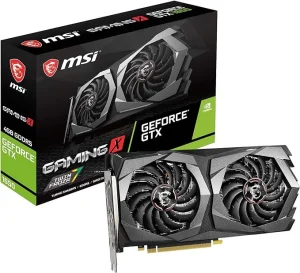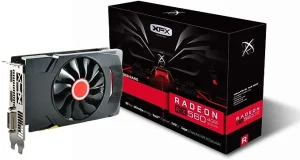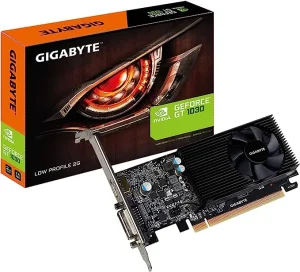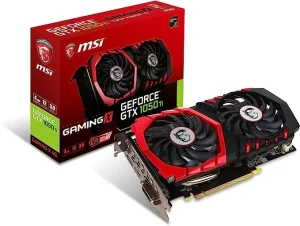5 Best low powered GPU in 2024
Looking for the best low-powered GPU? Look no further! If you’re searching for a graphics card that offers excellent performance while being energy-efficient, a low-powered GPU is the way to go. These power-efficient gems are perfect for those who want to enhance their gaming or work experience without compromising on energy consumption. Get ready to discover the perfect balance between power and performance!
5 Best low powered GPU in 2024
| Serial No. | Product Name | Check Price |
| 1 | NVIDIA GeForce GTX 1650 | Check Price |
| 2 | AMD Radeon RX 560 | Check Price |
| 3 | NVIDIA GeForce GT 1030 | Check Price |
| 4 | AMD Radeon RX 550 | Check Price |
| 5 | NVIDIA GeForce GTX 1050 Ti | Check Price |
1. NVIDIA GeForce GTX 1650

| Specification | Details |
| Chipset | NVIDIA GeForce GTX 1650 |
| Video Memory | 4GB GDDR5 |
| Memory Interface | 128-bit |
| Power Consumption | 85 W |
| Recommended PSU | 300 W |
| Maximum Displays | Supports up to 3x Display |
| Output | DisplayPort x 2 (V1.4)/ HDMI 2.0B x 1 |
When it comes to finding the best low-powered GPU, the NVIDIA GeForce GTX 1650 is a top contender. With its impressive specifications and efficient power consumption, it delivers a great balance between performance and energy efficiency.
The GTX 1650 is equipped with 4GB of GDDR5 video memory and a 128-bit memory interface, allowing for smooth and seamless graphics rendering. Whether you’re a gamer or a content creator, this GPU can handle most tasks with ease.
One of the standout features of the GTX 1650 is its low power consumption. With a power requirement of just 85W, it is incredibly efficient, making it an ideal choice for those who want to minimize their energy usage without sacrificing performance.
This GPU also supports up to three display monitors, allowing you to multitask or immerse yourself in a multi-monitor gaming setup. With two DisplayPort 1.4 outputs and an HDMI 2.0B output, you have flexibility in connecting your preferred display devices.
Pros:
- Efficient power consumption, making it a great choice for low-power systems.
- Decent performance for its price range.
- Supports multiple display monitors, allowing for versatile setups.
- Compact size, making it suitable for smaller form factor builds.
- Offers good value for its price point.
Cons:
- Not suitable for high-end gaming or demanding graphics-intensive tasks.
- Limited VRAM capacity may restrict performance in certain scenarios.
2. AMD Radeon RX 560

| Specification | Details |
| Chipset | AMD RX 560 |
| Memory | 4GB DDR5 |
| Stream Processors | 1024 |
| System RAM Type | DDR5 SDRAM |
When it comes to finding the best low-powered GPU, the AMD Radeon RX 560 stands out as a reliable option. Packed with impressive features and efficient power consumption, this GPU strikes a balance between performance and energy efficiency.
The RX 560 comes equipped with 4GB of DDR5 memory, providing ample space for smooth graphics rendering and multitasking. With 1024 stream processors, it delivers decent performance for its price range, making it suitable for casual gaming and content creation tasks.
One of the notable advantages of the RX 560 is its low power consumption. It is designed to be energy-efficient, ensuring that your system doesn’t draw excessive power while still delivering satisfactory performance. This makes it an excellent choice for users who are conscious about energy consumption.
The RX 560 is compatible with various display setups, allowing you to connect multiple monitors for enhanced productivity or an immersive gaming experience.
Pros:
- Efficient power consumption, making it an ideal choice for low-power systems.
- Decent performance for its price range, suitable for casual gaming and content creation.
- Compatible with multiple display setups, allowing for enhanced productivity or immersive gaming experiences.
- Supports modern technologies like DirectX 12 and Vulkan for improved graphics rendering.
- Offers good value for its price point.
Cons:
- Not suitable for high-end gaming or demanding graphics-intensive tasks.
- Limited VRAM capacity may restrict performance in certain scenarios.
3. NVIDIA GeForce GT 1030

| Specification | Details |
| Core Clock (MHz) | 1506 in OC mode, 1468 in gaming mode |
| Card Length | 150mm (low profile design) |
| Power Requirement | 300W |
| Memory | 2GB GDDR5 64-bit |
| Overclocking | One-click overclocking via AORUS Graphics Engine |
| Form Factor | Low profile |
When it comes to finding the best low-powered GPU, the NVIDIA GeForce GT 1030 is a reliable option that offers a balance between performance and energy efficiency. With its compact size and impressive features, it caters to users who require a low-profile graphics card for their systems.
The GT 1030 comes with a core clock speed of 1506 MHz in OC mode and 1468 MHz in gaming mode. While it may not be the most powerful GPU in the market, it delivers satisfactory performance for casual gaming and multimedia tasks. It provides a noticeable upgrade over integrated graphics, allowing for smoother gameplay and better visual quality.
One of the standout features of the GT 1030 is its low-profile design, with a card length of just 150mm. This makes it suitable for small form factor systems or HTPC where space is limited. Despite its compact size, it still manages to offer decent performance and can handle modern games at lower settings.
The GT 1030 incorporates 2GB of GDDR5 memory with a 64-bit memory interface, ensuring smooth rendering of graphics and textures. While the VRAM capacity may be considered limited for demanding tasks, it is sufficient for casual gaming and everyday computing needs.
Overclocking enthusiasts will appreciate the one-click overclocking feature provided by the AORUS Graphics Engine. This allows users to push the performance of the GT 1030 further, extracting additional power when needed.
Pros:
- Low power consumption, making it suitable for low-power systems.
- Compact and low-profile design, ideal for small form factor builds.
- Decent performance for casual gaming and multimedia tasks.
- One-click overclocking feature for enthusiasts.
- Affordable price point.
Cons:
- Not suitable for high-end gaming or demanding graphics-intensive tasks.
- Limited VRAM capacity may restrict performance in certain scenarios.
4. AMD Radeon RX 550

| Specification | Details |
| Graphics Coprocessor | AMD Radeon RX 550 |
| Brand | QTHREE |
| Graphics RAM Size | 4.00 |
| GPU Clock Speed | 1180 MHz |
| Video Output Interface | DisplayPort, DVI, HDMI |
When it comes to searching for the best low-powered GPU, the AMD Radeon RX 550 is a solid contender. With its efficient power consumption and a range of features, it strikes a balance between performance and energy efficiency.
The RX 550, in collaboration with QTHREE, offers a reliable option for users who require a low-profile graphics card. Designed for budget-conscious individuals, this GPU provides satisfactory performance for casual gaming and multimedia tasks.
With a GPU clock speed of 1180 MHz, the RX 550 delivers decent performance for its price range. While it may not handle the most demanding games or graphics-intensive applications, it still provides a noticeable upgrade over integrated graphics, ensuring smoother gameplay and improved visual quality.
The RX 550 comes with 4GB of graphics RAM, allowing for efficient rendering and smooth multitasking. This capacity is generally sufficient for casual gaming and everyday computing needs, though it may be limited to more demanding scenarios.
One of the highlights of the RX 550 is its versatile video output interface, including DisplayPort, DVI, and HDMI. This allows for easy connectivity to a variety of display devices, providing flexibility for different setups and monitor configurations.
Pros:
- Efficient power consumption, making it suitable for low-power systems.
- Affordable price point, ideal for budget-conscious users.
- Decent performance for casual gaming and everyday tasks.
- Versatile video output interface for easy connectivity.
- Compact size and low-profile design.
Cons:
- Not suitable for high-end gaming or demanding graphics-intensive tasks.
- Limited VRAM capacity may restrict performance in certain scenarios.
5. NVIDIA GeForce GTX 1050 Ti

| Specification | Details |
| Chipset | NVIDIA GeForce GTX 1050 Ti |
| Video Memory | 4GB GDDR5 |
| Memory Interface | 128-bit |
| Cores | 768 units |
| Max. Resolution | 2560 x 1600 (supports 3x display monitors) |
| Card Dimension (mm) | 229 x 131 x 39 |
| Digital Max. Resolution | 7680 x 4320 |
When it comes to finding the best low-powered GPU, the NVIDIA GeForce GTX 1050 Ti is a reliable choice that offers a balance between performance and energy efficiency. With its impressive specifications and features, it caters to users who require a powerful yet efficient graphics card for their systems.
The GTX 1050 Ti is built on the NVIDIA GeForce GTX 1050 chipset, providing a solid foundation for graphics processing. With 4GB of GDDR5 video memory and a 128-bit memory interface, it delivers smooth rendering and efficient multitasking capabilities. This ensures that games and multimedia applications run smoothly, even at higher resolutions and detail settings.
With 768 units of cores, the GTX 1050 Ti offers sufficient power for gaming and creative workloads. While it may not compete with higher-end GPUs, it provides a noticeable performance boost over its predecessors and integrated graphics solutions. It can handle modern games at medium to high settings, delivering an enjoyable gaming experience.
One of the standout features of the GTX 1050 Ti is its support for multiple display monitors. With a maximum resolution of 2560 x 1600 and the ability to connect up to three displays, it provides flexibility for multitasking, productivity, and immersive gaming experiences.
In terms of physical dimensions, the card measures 229 x 131 x 39 millimeters, making it suitable for a variety of PC builds. Additionally, it supports a digital maximum resolution of 7680 x 4320, ensuring compatibility with high-resolution displays and future-proofing your system.
Pros:
- Efficient power consumption, making it suitable for low-power systems.
- Solid performance for gaming and multimedia tasks.
- Multiple display support for enhanced productivity and immersive gaming.
- Compact size, suitable for various PC builds.
- Future-proof with support for high-resolution displays.
Cons:
- Not suitable for ultra-high settings in demanding games.
- Limited VRAM capacity may restrict performance in certain scenarios.
Buying Guide: 6 Factors to Consider When Choosing the Best Low-Powered GPU
Power Efficiency: One of the key reasons for opting for a low-powered GPU is to minimize energy consumption. Look for GPUs that are specifically designed for efficiency, as they will provide satisfactory performance while keeping power consumption to a minimum. Consider checking the power ratings and certifications to ensure you’re choosing an energy-efficient option.
Performance: While low-powered GPUs are designed to be energy-efficient, it’s important to find a balance between power consumption and performance. Assess your usage requirements and choose a GPU that can handle your desired tasks, whether it’s casual gaming, multimedia editing, or graphic design. Look for GPUs with sufficient VRAM and core counts for smooth performance in your preferred applications.
Compatibility: Ensure that the GPU you choose is compatible with your system’s specifications. Check the GPU’s interface, dimensions, and power requirements to ensure it can physically fit in your PC case and that your power supply can support it. Additionally, consider compatibility with your operating system and any specific software you plan to use.
Connectivity Options: Consider the connectivity options provided by the GPU. Look for GPUs with a variety of video output interfaces, such as HDMI, DisplayPort, and DVI, to ensure compatibility with your monitor or display setup. Additionally, if you require multiple displays, ensure that the GPU supports the desired number of monitors and their respective resolutions.
Price and Value: Determine your budget and evaluate the price-to-performance ratio of the GPUs you are considering. Compare the features, performance, and power efficiency of different models to find the best value for your money. Remember that the most expensive option may not always be the best fit for your needs, so consider your requirements carefully.
Reviews and Feedback: Before making a final decision, read reviews and seek feedback from other users or reputable sources. This will provide insights into real-world performance and reliability. Pay attention to both the positive and negative aspects mentioned in the reviews to understand the strengths and weaknesses of each GPU.
FAQ’s
1. What does “low-powered GPU” mean?
A low-powered GPU refers to a graphics processing unit that consumes less energy compared to its higher-performance counterparts. These GPUs are designed to provide satisfactory performance while minimizing power consumption.
2. Will a low-powered GPU be able to handle modern games?
While low-powered GPUs may not offer the same level of performance as high-end models, they can still handle modern games at lower to medium settings.
3. Can a low-powered GPU support multiple displays?
Yes, many low-powered GPUs are capable of supporting multiple displays. However, the number of displays and their respective resolutions that a GPU can handle may vary. Check the specifications of the GPU you are considering to ensure it meets your multi-monitor needs.
4. Do low-powered GPUs require additional power connectors?
It depends on the specific GPU model and its power requirements. While some low-powered GPUs can draw power solely from the motherboard’s PCIe slot, others may require additional power connectors from the power supply unit. Check the GPU’s specifications and ensure your power supply can accommodate its requirements.
5. Will a low-powered GPU be compatible with my existing system?
Compatibility will depend on various factors such as the GPU’s interface, dimensions, power requirements, and software compatibility.
Conclusion
Choosing the best low-powered GPU requires careful consideration of various factors. By prioritizing power efficiency, performance, compatibility, connectivity options, price, and value, you can find a GPU that meets your specific needs while minimizing energy consumption. Remember to read reviews and seek feedback from other users to gain insights into real-world performance.
It’s important to assess your requirements and budget to make an informed decision. Whether you’re a casual gamer, a multimedia enthusiast, or a graphic designer, selecting the right low-powered GPU will ensure a satisfactory experience without compromising on power efficiency. So, take your time, do your research, and happy GPU hunting!
